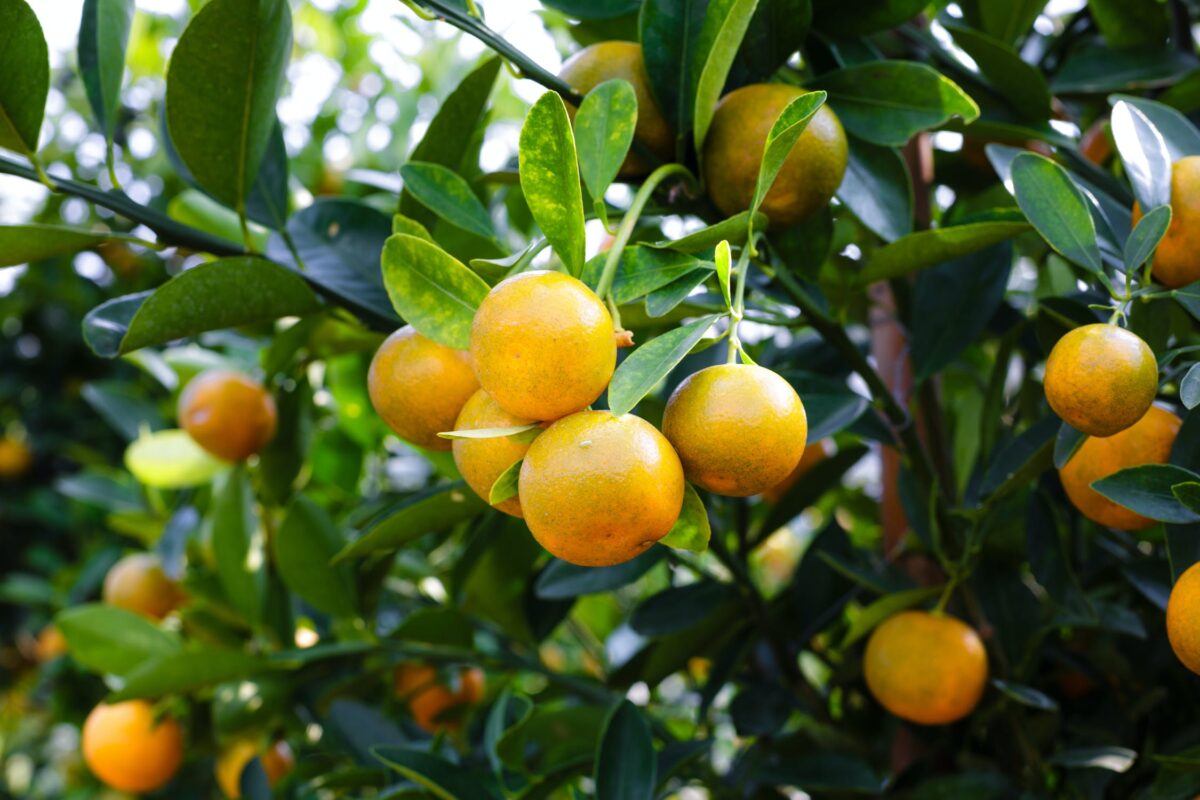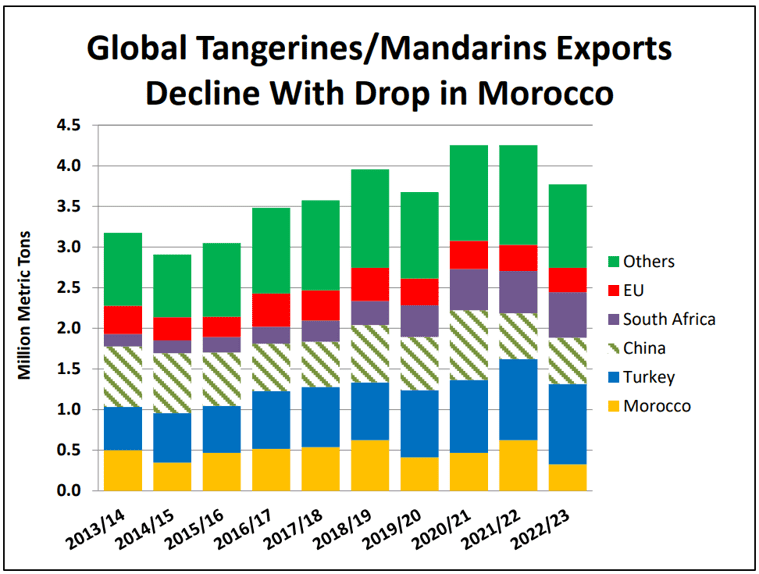Global Citrus Production Outlook – Record Exports Forecast for South Africa Mandarins

In a world where citrus production is facing various challenges and fluctuations, South Africa’s mandarin industry is defying the odds and reaching new heights. Looking at the global citrus production outlook, South Africa’s higher citrus production, coupled with strong overseas demand will increase its exports of tangerines/mandarins by approximately 8 percent by the end of 2023 season, reaching an unprecedented record of 560,000 tons.
The European Union and the United Kingdom are the primary recipients of South Africa’s citrus bounty, accounting for 45 percent of total exports. Following closely behind are Russia and the United States, each representing 10 percent of the export market. South Africa’s fruitful partnership with the United States under the African Growth and Opportunity Act (AGOA) has been a key driver behind the exponential growth of mandarin exports to the American market. Over the past five years, exports to the US have quadrupled, soaring to nearly 50,000 tons in the previous season.

Source: The USDA Foreign Agricultural Service – Global Citrus Production Outlook
This upward trend is expected to continue as consumer preference for tangerines/mandarins in the United States continues to rise, bolstered by the ongoing duty-free market access provided by AGOA. While local consumption of tangerines/mandarins remains relatively smaller compared to oranges, the industry’s focus on export markets and the implementation of pest management netting have resulted in higher quality produce and reduced surplus fruit. However, there is a niche market within the country, where high-end retail chains cater to domestic consumers by offering export-grade citrus.
Looking ahead to the 2023 season, the outlook for South Africa’s citrus production is remarkably optimistic. Tangerines/mandarins are expected to see a 6 percent increase in production, reaching a total of 670,000 tons. This growth can be attributed to favorable weather conditions and the increasing number of newly planted orchards entering full production.
Over the past seven years, the area dedicated to tangerines/mandarins has experienced significant expansion, driven by global demand for seedless varieties and the comparatively higher profit margins they offer. However, this rapid growth in planted area is anticipated to slow down in the upcoming season due to concerns of softening demand and rising costs. Economic growth projections indicate potential weakening in key markets such as the European Union and the United Kingdom, accompanied by inflationary pressures that may dampen consumer spending on imported fruit.
Furthermore, challenges related to rising farm input costs, higher shipping rates, infrastructure inefficiencies, ineffective port operations, and deteriorating road networks have started to impact the industry’s profitability, limiting further investment. As a result, the forecasted growth in the area planted for tangerines/mandarins in the 2023 season is only 1 percent, amounting to approximately 28,225 hectares compared to the previous year’s estimated 7-percent growth.
Within South Africa, the Western Cape province dominates tangerine/mandarin production, accounting for 37 percent of the country’s total output. Following closely behind are the Limpopo and Eastern Cape provinces, contributing 28 percent and 25 percent, respectively. With more than 50 percent of the orchards in the country being younger than 5 years, there is a substantial potential for increased production in the coming years.
While South Africa stands at the forefront of mandarin production and export, the global outlook for citrus, including oranges, grapefruit, and lemons/limes, is experiencing fluctuations and challenges of its own.

Source: The USDA Foreign Agricultural Service
For oranges, global production in the 2023 season is estimated to decrease by 5 percent, reaching 47.5 million tons. Lower production in the European Union and the United States is only partially offset by a larger crop in Egypt. In the United States, citrus production has been significantly impacted by several factors, including the spread of citrus greening disease and extreme weather events such as hurricanes.
In the European Union, citrus production is projected to decline due to unfavorable weather conditions and disease outbreaks. Spain, one of the largest citrus producers in the region, has been particularly affected by adverse weather patterns, leading to a decrease in orange production. Additionally, the spread of the citrus black spot disease has resulted in stricter import regulations imposed by the European Union, affecting the availability and trade of citrus products.
The United States, another major player in the global citrus market, has been grappling with the challenges posed by citrus greening disease. This devastating bacterial infection has significantly impacted citrus trees, leading to a decline in production and the need for extensive pest management efforts. The state of Florida, which historically produced a significant portion of the country’s oranges, has been heavily affected by citrus greening, resulting in a notable reduction in orange output.

Source: The USDA Foreign Agricultural Service
To compensate for the decrease in production in traditional citrus-growing regions, Egypt has emerged as a key player in the global orange market. The country has experienced a significant increase in orange production, driven by favorable weather conditions and expanding cultivation areas. Egypt’s strategic location, allowing for convenient access to major markets in Europe, the Middle East, and Asia, has further strengthened its position as a major citrus exporter.
Despite the challenges faced by the global orange industry, demand for citrus products remains strong. Oranges are a popular fruit worldwide, consumed both fresh and in processed forms such as juices and concentrates. The nutritional benefits and versatile uses of oranges continue to drive consumer demand, contributing to a steady market for orange producers.
In addition to oranges, other citrus fruits like grapefruit and lemons/limes also face their own set of challenges. Grapefruit production has been declining in several countries, including the United States, due to factors such as disease pressure, competition from other citrus varieties, and changing consumer preferences. The popularity of grapefruit has waned in some markets, leading to decreased demand.

Source: The USDA Foreign Agricultural Service
Lemons and limes, on the other hand, have seen a relatively stable global production trend. These citrus fruits are widely used in culinary applications, beverages, and various consumer products. However, fluctuations in production and trade can occur due to factors such as weather conditions, disease outbreaks, and market dynamics.

Source: The USDA Foreign Agricultural Service
While the global citrus industry is navigating a complex landscape of challenges and opportunities, it is crucial for citrus producers to adapt to changing market conditions, invest in research and innovation, and implement effective pest and disease management strategies to ensure the long-term sustainability and profitability of the industry.
Read Full Report on the Global Citrus Production Outlook from the The USDA Foreign Agricultural Service



